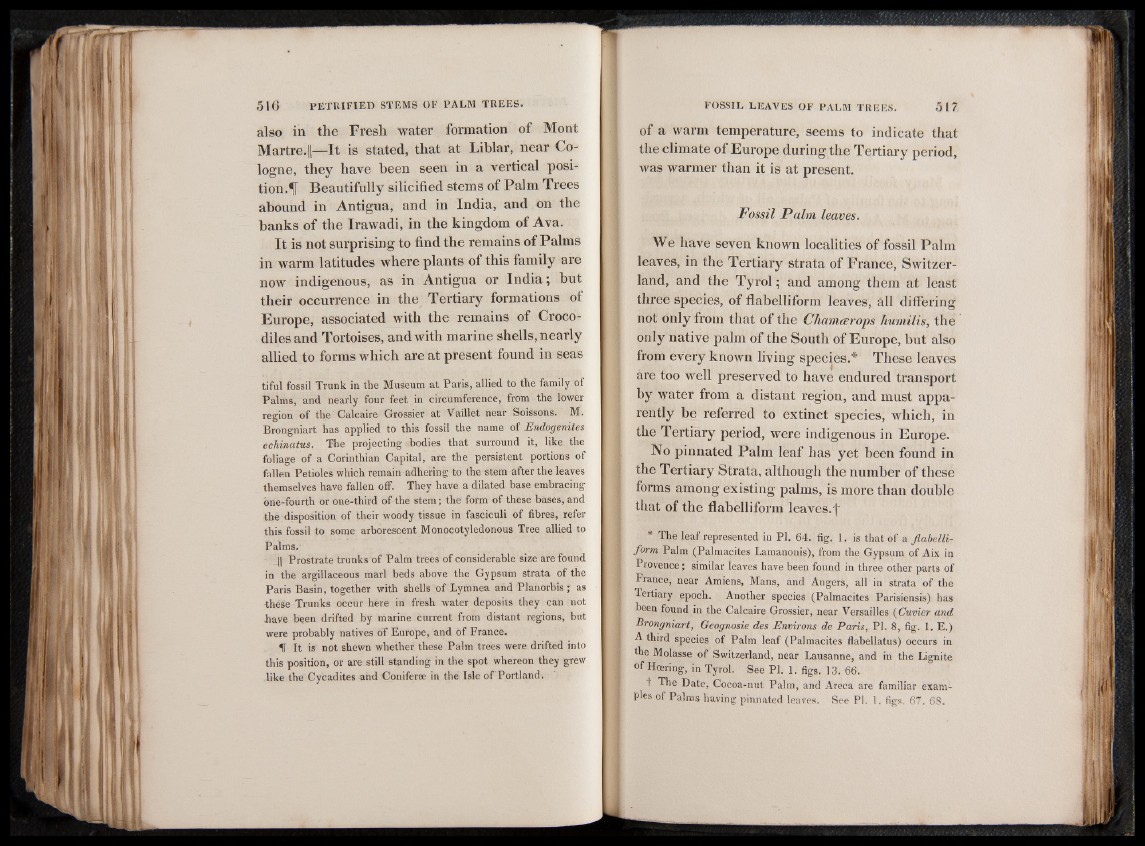
also in the Fresh water formation of Mont
Martre.||— It is stated, that at Liblar, near Cologne,
they have been seen in a vertical position.^!
Beautifully silicified stems of Palm Trees
abound in Antigua, and in India, and on the
banks of the Irawadi, in the kingdom of Ava.
It is not surprising to find the remains of Palms
in warm latitudes where plants of this family are
now indigenous, as in Antigua or India; but
their occurrence in the Tertiary formations of
Europe, associated with the remains of Crocodiles
and Tortoises, and with marine shells, nearly
allied to forms which are at present found in seas
tiful fossil Trunk in the Museum at Paris, allied to the family of
Palms, and nearly four feet in circumference, from the lower
region of the Calcaire Grossier at Vaillet near Soissons. M.
Brongniart has applied to this fossil the name of Endogenites
echinatus. The projecting bodies that surround it, like the
foliage of a Corinthian Capital, are the persistent portions of
fallen Petioles which remain adhering to the stem after the leaves
themselves have fallen off. They have a dilated basé embracing
one-fourth or one-third of the stem; the form of these bases, and
the disposition of their woody tissue in fasciculi of fibres, refer
this fossil to some arborescent Monocotyledonous Tree allied to
Palms.
j| Prostrate trunks of Palm trees of considerable size are found
in the argillaceous marl beds above the Gypsum strata of the
Paris Basin, together with shells of Lymnea and Planorbis ; as
these Trunks occur here in fresh water deposits they can not
■have been drifted by marine current from distant regions, but
were probably natives of Europe, and of France.
flf It is not shewn whether these Palm trees were drifted into
this position, or are still standing in the spot whereon they grew
like the Cycadites and Coniferse in thé Isle of Portland.
of a warm temperature, seems to indicate that
the climate of Europe during the Tertiary period,
was warmer than it is at present.
Fossil Palm, leaves.
We have seven known localities of fossil Palm
leaves, in the Tertiary strata of France, Switzerland,
and the Tyrol; and among them at least
three species, of flabelliform leaves, all differing
not only from that of the Chamcerops humilis, the
only native palm of the South of Europe, but also
from every known living species.* These leaves
are too well preserved to have endured transport
by water from a distant region, and must apparently
be referred to extinct species, which, in
the Tertiary period, were indigenous in Europe.
No pinnated Palm leaf has yet been found in
the Tertiary Strata, although the number of these
forms among existing palms, is more than double
that of the flabelliform leaves.'!'
* The leaf represented in PI. 64. fig. 1. is that of a flabelli-
form Palm (Palmacites Lamanonis), from the Gypsum of Aix in
Provence; similar leaves have been found in three other parts of
France, near Amiens, Mans, and Angers, all in strata of the
Tertiary epoch. Another species (Palmacites Parisiensis) has
been found in the Calcaire Grossier, near Versailles ( Cuvier and
Brongniart, Geognosie des Environs de Paris, PI. 8, fig. 1. E.)
A third species of Palm leaf (Palmacites flabellatus) occurs in
the Molasse of Switzerland, near Lausanne, and in the Lignite
of Hoering, in Tyrol. See PL 1. figs. 13. 66.
t The Date, Cocoa-nut Palm, and Areca are familiar examples
of Palms having pinnated leaves. See PI. 1. figs. 67. 68.